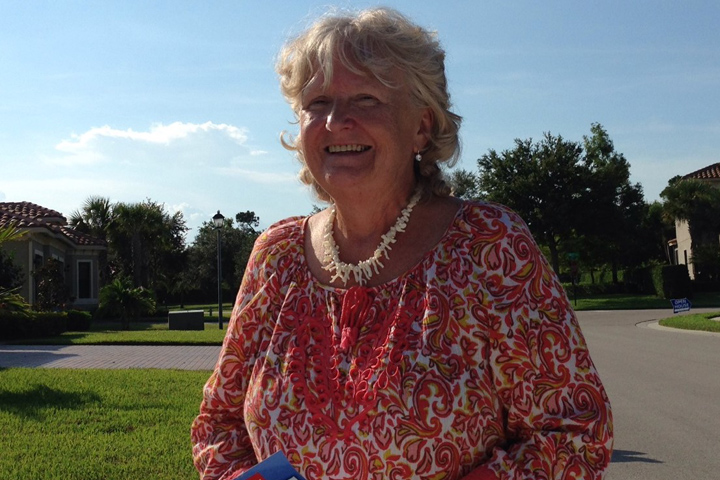Failure is Not an Option

- Chemotherapy and radiation plus a blood pressure drug to shrink my tumor
- Surgery removes two-thirds of my pancreas
- Mop-up chemotherapy
- Nodules in my lungs start to grow, possibly requiring more treatment
I am Christine Shaffer, 67 years old. In 2017 I was diagnosed with pancreatic cancer.
I had been having lower back pain. My doctor diagnosed me with a urinary tract infection (UTI) and prescribed antibiotics. But a couple of weeks later I began experiencing similar symptoms again—the pain was affecting my abdomen along with my lower back pain. I went to get rechecked and found out that I did not have a UTI. A CT scan revealed a mass on my pancreas. After a meeting with an oncologist and having an endoscopy done it was confirmed that I had a 2.7 x 2.8 cm tumor near the tail of my pancreas. There were no visible metastases and no spread to the lymph nodes.
Starting Treatment
I went to the Moffitt Cancer Center, in Tampa, Florida, where the Tumor Board set out a plan for chemotherapy, radiation, and then surgery (neoadjuvant treatment). The chemo (FOLFIRINOX) was brutal. I had four cycles, which were very debilitating. I could not eat or drink . . . even drinking water was difficult. I lost 35 pounds and went to the ER at least four times due to dehydration. But I persevered and made it through.
My husband (who had some training in biomedical engineering) was my biggest advocate. He researched night and day looking for everything he could find about my cancer and how to best treat it. He found that Dr. Theodore Hong at Mass General in Boston was doing some research using losartan (a blood pressure drug) during the time of the chemo. My blood pressure was elevated so my primary care doctor prescribed losartan. During chemotherapy my tumor shrunk by 55 percent.
The next step was stereotactic body radiation treatment (SBRT). After SBRT the tumor shrunk to 25 percent of its original size and what remained was necrotic tissue. The tumor had been very close to abutting the superior mesenteric artery. After both chemo and radiation, it was a “go” for a distal surgery.
Two-thirds of my pancreas was removed, leaving the head. The surgery was done at Moffitt by Dr. Pamela Hodul and was a success. A vascular surgeon was on stand-by but was not needed. My spleen had to be removed, as the splenic artery had been occluded by the tumor (my gallbladder had been removed 40 years earlier). The pathology report showed no lymph node invasion. After the surgery I underwent three cycles of Gemzar, to clean up anything left.
I continue today under the care of Dr. William McGarry, my oncologist in Vero Beach, Florida. I am not a diabetic and I do not have to take digestive enzymes.
All Clear for a While
I was all clear for my first few three-month CT scans and CA 19-9 checks. But in August 2018 I hit a bump in the road. All along I, my husband, and my health care team have been worried about what were considered at the time of the surgery to be indeterminate pulmonary nodules (IPN). The problem was they were too small to biopsy safely and effectively, and most IPNs turn out to be benign. We were surprised that the nodules were virtually untouched after my treatment with FOLFIRINOX and Gemzar. Since the CA 19-9 before and after surgery was well within normal range, we adopted a wait and see approach.
In August my doctors noticed some growth in these nodules, and my CA 19-9 spiked to 486 from being in the normal range just three months before. Although the nodules are not growing rapidly, we are concerned. So, we are in the process of figuring out the next steps. We are going back to Moffitt to meet with Dr. Frank Kaszuba, a pulmonary oncologist. We would like to have a biopsy on the largest, most suspicious nodules, and then have molecular profiling done. Our course after that depends on the results of the biopsy and profiling.
Faith and the Right Doctors
My journey through this time and ultimately my success could not have been achieved without a reliance on and “rebirth” of my deep faith in God. It was what sustained me throughout the entire nine months of treatment. My journey through this cancer has been difficult I know there is more that I need to accomplish in this life and I am “forever changed” in a most positive way.
Prayer really helps but finding the best doctors and surgeons is crucial. When you get a diagnosis of pancreatic cancer you need to find an advocate, someone who can do the work of researching clinical studies, finding the latest treatments, and the best doctors and hospitals. I am so blessed to have a husband who can do all of those things. This is such a wicked disease, but failure is not an option.
Christine passed away in September 2019. She and her husband searched diligently for new treatments that would help her, and others after her. We offer our deep sympathy and admire the Shaffers’ determination to make a difference.






